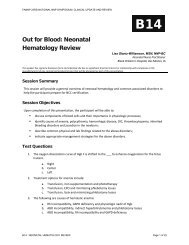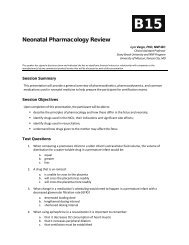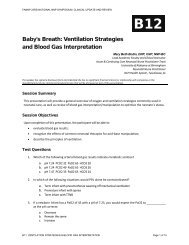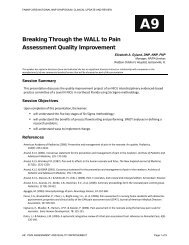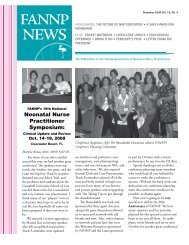Differential Diagnosis and Management of Respiratory ... - FANNP
Differential Diagnosis and Management of Respiratory ... - FANNP
Differential Diagnosis and Management of Respiratory ... - FANNP
You also want an ePaper? Increase the reach of your titles
YUMPU automatically turns print PDFs into web optimized ePapers that Google loves.
<strong>FANNP</strong> 23RD NATIONAL NNP SYMPOSIUM: CLINICAL UPDATE AND REVIEW<br />
Tracheal Agenesis <strong>and</strong> Atresis<br />
•Fetus is generally growing <strong>and</strong> doing well in<br />
utero<br />
•Immediate respiratory distress after<br />
delivery.<br />
•Inability to pass even the smallest ETT<br />
•Fatal unless there is presence <strong>of</strong><br />
bronchoesophageal fistula<br />
Esophageal Atresia &<br />
Tracheoesophageal Fistula<br />
• Can exist as separate<br />
congenital anomalies, but most<br />
present with both. Most are<br />
associated with other<br />
congenital anomalies.<br />
• Occurs when the trachea fails<br />
to differentiate <strong>and</strong> separate<br />
from the esophagus.<br />
• 1 - 2 /5000 live births<br />
• Predominance in white<br />
populations <strong>and</strong> in males <strong>and</strong> a<br />
disproportional rate <strong>of</strong><br />
twinning among affected<br />
infants.<br />
14<br />
X-Ray <strong>of</strong> Esophageal Atresia<br />
Radiography<br />
• Chest x-ray shows tube ending in pouch or coiling<br />
there.<br />
• Air in bowel indicates distal TEF.<br />
• Airless abdomen indicates no fistula present.<br />
• Contrast studies generally contraindicated but may<br />
be necessary if H-type fistula is suspected.<br />
15<br />
16<br />
Presentation<br />
• Clinically, cannot pass an OG tube or NG tube past 9<br />
-12 cm.<br />
• As oral secretions <strong>and</strong> saliva collect in the upper<br />
esophageal pouch, the infant will present with large<br />
amounts <strong>of</strong> oral secretions due to lack <strong>of</strong> ability to<br />
swallow.<br />
• Coughing, choking, <strong>and</strong> cyanosis during feedings is a<br />
common presentation with TEF.<br />
• Secretions may be aspirated in cases <strong>of</strong> fistula.<br />
Initial <strong>Management</strong><br />
• As with any problem causing respiratory distress in<br />
the neonate, airway patency <strong>and</strong> ventilation is a<br />
priority.<br />
• Secretions may be aspirated in cases <strong>of</strong> fistula.<br />
• The triad <strong>of</strong> excessive secretions, reflux, <strong>and</strong><br />
respiratory distress especially in the presence <strong>of</strong><br />
maternal hx <strong>of</strong> polyhydramnios indicates TEF until<br />
otherwise ruled out.<br />
17<br />
18<br />
B07: MANAGEMENT OF RESPIRATORY DISTRESS Page 5 <strong>of</strong> 23



